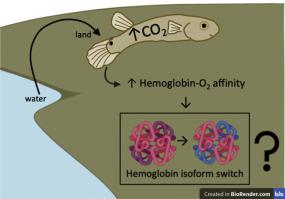Comparative Biochemistry and Physiology A: Molecular & Integrative Physiology ( IF 2.3 ) Pub Date : 2020-11-17 , DOI: 10.1016/j.cbpa.2020.110848 Louise Tunnah 1 , Cayleih E Robertson 2 , Andy J Turko 3 , Patricia A Wright 1

|
When the amphibious mangrove rivulus (Kryptolebias marmoratus) leaves water for extended periods, hemoglobin-O2 binding affinity increases. We tested the hypothesis that the change in affinity was a consequence of hemoglobin isoform switching driven by exposure to environments associated with increased internal CO2 levels. We exposed K. marmoratus to either water (control, pH 8.1), air, aquatic hypercarbia (5.1 kPa CO2, pH 6.6–6.8), or aquatic acid (isocarbic control, pH 6.6–6.8), or for 7 days, and measured hemoglobin-O2 affinity spectrophotometrically. We found that mangrove rivulus compensated for elevated CO2 and aquatic acid exposure by shifting hemoglobin-O2 affinity back to aquatic (control) levels when measured at an ecologically-relevant high CO2 level that would be experienced in vivo. Using proteomics, we found that the hemoglobin subunits present in the blood did not change between treatments, but air and aquatic acid exposure altered the abundance of cathodic hemoglobin subunits. We therefore conclude that hemoglobin isoform switching is not a primary strategy used by mangrove rivulus to adjust P50 under these conditions. Abundances of other RBC proteins also differed between treatment groups relative to control fish (e.g. Rhesus protein type A, band 3 anion exchanger). Overall, our data indicate that both aquatic hypercarbia and aquatic acidosis create similar changes in hemoglobin-O2 affinity as air exposure. However, the protein-level consequences differ between these groups, indicating that the red blood cell response of mangrove rivulus can be modulated depending on the environmental cue received.
中文翻译:

适应长时间的水生高碳血症或空气会增强两栖鱼类的血红蛋白氧亲和力
当两栖红树林小溪(Kryptolebias marmoratus)长时间离开水时,血红蛋白-O 2的结合亲和力增加。我们检验了以下假设:亲和力的变化是血红蛋白同工型转换的结果,而血红蛋白同工型转换是由于暴露于与内部内部CO 2水平升高相关的环境而驱动的。我们暴露K.鳢要么水(对照,pH值8.1),空气,水生的高碳酸血症(5.1千帕的CO 2,pH值6.6-6.8),或水生酸(isocarbic控制,pH值6.6-6.8),或7天,和分光光度法测定血红蛋白-O 2亲和力。我们发现红树林溪流补偿了CO 2的升高通过在体内遇到的与生态相关的高CO 2水平下测量血红蛋白-O 2亲和力回到水生(对照)水平来暴露水酸。使用蛋白质组学,我们发现在治疗之间血液中存在的血红蛋白亚基没有变化,但是空气和水酸的暴露改变了阴极血红蛋白亚基的丰度。因此,我们得出结论,血红蛋白亚型转换不是红树林小溪用来调节P 50的主要策略。在这些条件下。相对于对照鱼,治疗组之间其他RBC蛋白的丰度也有所不同(例如,恒河猴A型蛋白,带3阴离子交换剂)。总体而言,我们的数据表明,水生高碳血症和水生酸中毒均使血红蛋白-O 2亲和力产生与空气暴露相似的变化。但是,这些组之间的蛋白质水平后果不同,表明红树林小溪的红细胞反应可以根据收到的环境提示进行调节。



























 京公网安备 11010802027423号
京公网安备 11010802027423号